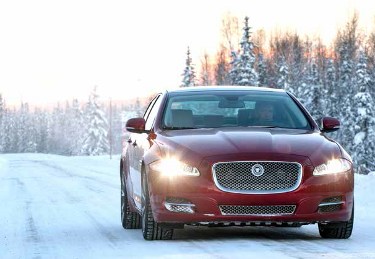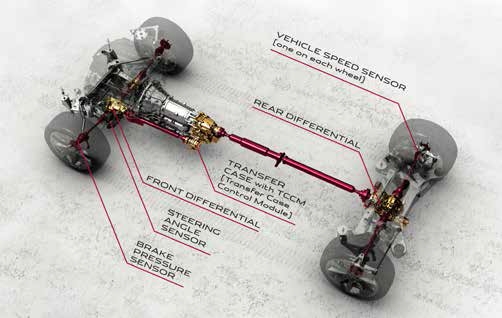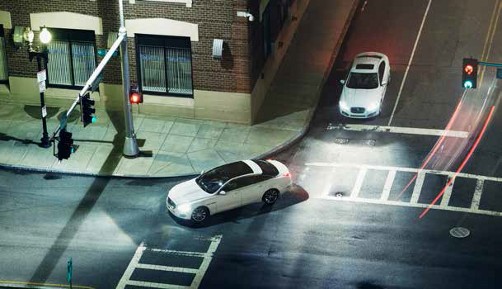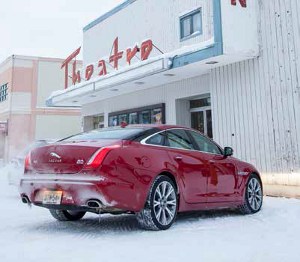 |
| December 03, 2013 | Volume 09 Issue 45 |
Designfax weekly eMagazine
Archives
Partners
Manufacturing Center
Product Spotlight
Modern Applications News
Metalworking Ideas For
Today's Job Shops
Tooling and Production
Strategies for large
metalworking plants
Wheels:
Jaguar conquers America's Snowbelt with 4WD
For Jaguar, competing across the broad swathe of "Snowbelt" states in North America meant equipping its XJ and XF luxury sedans with four-wheel drive. Time was short, so Ricardo was summoned to help.
Jesse Crosse reports.

[All images courtesy: Ricardo/Jaguar Land Rover]
Seizing the moment is crucial to the successful running of a dynamic business. For a luxury car manufacturer like Jaguar, the ability to tap into a niche market with a carefully targeted derivative can sometimes be crucial, especially if that niche is a large one. But doing so often demands action at relatively short notice, and in the automotive business that requires not just financial resources but skilled engineering expertise too.
Following the success of its 2010 model year portfolio of products, which included impressive new diesel and gasoline engines, Jaguar found itself coming out of the recession at some speed. "Since then the business has continued to expand and my team has doubled in size over the last three to four years," says Jaguar Land Rover chassis director David Waide. Jaguar's response to its renewed success has been to put more content into its cycle plan. One of the markets it had been keen to tackle for some time was the so-called North American snowbelt -- those states that endure heavy snowfall during long winters each year.
Because of the unrelentingly grim conditions, around 70 percent of sales in the Snowbelt are for four-wheel drive cars, something Jaguar did not have in its line-up and which clearly meant missing out on significant sales. So the engineering teams began to look at the feasibility of equipping derivatives of the left-hand drive Jaguar XJ and Jaguar XF rear-wheel drive sedans with four-wheel drive. The change would be applied only to Models equipped with the new 3.0 V6 supercharged gasoline engine, which had only just been introduced for the 2013 model year.
Advanced packaging studies
This was no mean undertaking; no allowance had been made in the original architecture for a four-wheel drive transmission, but Ricardo supported advanced packaging work at Jaguar, produced positive results and the project was approved. The big problem would be finding sufficient engineering resource since Jaguar Land Rover is on a significant growth curve and despite a huge expansion in the size of its engineering team, the company is still operating at full stretch. "It's always more challenging doing two cars at the same time," explains Waide, "although in this case suspension and powertrain similarities meant it was more like tackling one and a half cars."
This was early in 2010 and the pressure was on because it was crucial not to miss any more winter sales than absolutely necessary. The search for a suitable supplier began, explains Waide: "We looked at our own capacity and recruited heavily, but struggled to find enough engineers with the right skills. So we reviewed outsource partners and went through assessments with them to gauge technical capability, our confidence in their delivery, their cost effectiveness and especially looking at expertise in the areas we knew we would need their engineering capability. Ricardo was the successful contender."

Four-wheel drive editions of the XJ and XF use a transfer-case version of the ZF eight-speed automatic transmission plus a propshaft, differential and driveshafts taking torque to the front wheels. Changes were needed to the exhaust and steering systems as well as the wiring harness.
Ricardo was already working on another program for Jaguar involving the same cars, that of adding the 2.0 GTDi four-cylinder engine to the existing range. The ability to draw upon its own global resources in order to fulfil the new projects was a huge bonus and expertise was called upon from its engineering centers in Michigan and Prague. The team was centered at Ricardo's Midlands Technical Centre at Leamington Spa, not far from the Jaguar Land Rover Engineering Centres at Gaydon and Whitley, near Coventry.
"We decided at the beginning to treat Ricardo as part of our own team, so instead of creating a firewall between us, we put in place normal management reporting structures for senior management responsibility, with Ricardo feeding in to it," remembers Waide. "The Jaguar team knew they were free to share all information and that a confidentiality agreement was in place. The principal objective was to create a relationship that was as open as possible on the basis that the easier things are, the more successful the end result will be. We asked that a management structure was put in place by Ricardo, with team leaders and appropriate communication channels just like any other program handled internally."
Challenging project
The challenging project got off to a strong start and Ricardo's skills were immediately tested in mastering the Jaguar Land Rover Product Creation System with its strict failure mode avoidance procedures. "Ricardo responded well, kept listening and working with us, reacting to any concerns and then addressing them. After that things ran very smoothly because of the focus early on, and the launch to market was smooth and robust," says Waide.
The ability to integrate with business processes would quickly prove to be essential as time was short. "Formal, deliverables-based support for the XJ began in July 2010 within a week or two of the separate GTDI project, with the XF kicking off in October 2010" says Ricardo product group director, Graeme Stewart. Job One would be in November 2012.
The project would involve a substantial redesign of the front chassis and suspension components to incorporate a front differential sitting beneath the engine; the driveshafts would need to pass through the suspension knuckles where no drive path existed before. The task would involve the installation of a four-wheel drive version of the ZF eight-speed automatic transmission with integral transfer case, the routing of the propshaft to the front differential, and there would have to be changes to the exhaust system. The steering rack would also be affected, and so would the front chassis geometry and the electrical wiring harness.
"It was quite a challenge," says Ricardo chief engineer on the project, John French. "Going from four-wheel drive to two-wheel drive is relatively easy as you're taking components away. In this case we had to integrate relatively large chunks of hardware into a package that hadn't originally been created for that purpose, while maintaining Jaguar's crucial driving attributes."
Delivering Jaguar dynamics
Driving attributes are critical to 'Jaguar DNA' and it is widely acknowledged that Jaguar's Vehicle Engineering Team is one the best in the business when it comes to agile cars with sharp and distinctive steering and handling. "There's an enormous focus on vehicle attributes in what we do," explains Waide. "We identify the different behaviors of the car -- occupant packaging, driving feel, fuel consumption and so on. Then we set targets for them all and break them down into five levels of granularity. Understanding our customers, knowing what they're looking for and then delivering those attributes lies at the heart of our success."

To preserve the excellent dynamics of the original car, Ricardo designed a special front subframe to accommodate the differential and driveshafts with only a minimal increase in engine height.
Jaguar engineers use a subjective scale for vehicle dynamics, and it is that set of attributes established for the rear wheel-drive cars that the Ricardo team would need to protect. In revising the entire front suspension system, no more than half a point drift in performance would be allowed in the attribute targets. In this respect, the changes were daunting. A front differential could be installed with comparative ease if the engine was raised high enough, but clearly any such change would have to be minimized to avoid raising the center of gravity too high, or bringing engine hard points in too close a proximity to the engine hood, affecting pedestrian safety.
Ricardo designed an all-new front sub-frame to accommodate the differential and driveshafts. The new sub-frame and steering gear was lowered, allowing the engine to be raised by only 5 mm and moved forward by 12 mm whilst maintaining the ride height of the XJ rear-wheel drive. Even the tighter package of the XF only required a 10-mm higher ride height than that of the standard vehicle. The upper and lower suspension arms, knuckles, anti-roll bar and associated drop-links also had to be redesigned for four-wheel drive. The XJ work started before the XF work but, as French says, "because we had the two teams in the same office, the learning we got from the XJ proved extremely useful."
Cost-focused design
The transfer case (which splits the drive between front and rear axles) is located in the transmission to the rear of the engine, with a propshaft coming forward to the new differential. This required new transmission mountings and modifications to the body at the attachment point. New struts were also needed to allow the propshafts to pass through, and the knuckles had to be equipped with a different type of wheel bearing to also accommodate the driveshaft.
"Ricardo also conducted a study into manufacturing processes looking at alternative design methodologies for the front yokes. This resulted in a more cost-effective approach and lifetime cost savings for our customer," explains Stewart. The large cast yoke bolted on in four places and provided an opportunity for the cost reduction. The Ricardo team identified that a two-piece bolt-on damper could be produced in one piece. At the same time it was possible to eliminate a structural undertray, giving a significant cost reduction.
The front suspension geometry, so crucial to achieving the Jaguar dynamic attributes, involved a lot of CAE work by Ricardo's chassis team to arrive at satisfactory values for the camber and caster angles as well as the all-important roll-centers, those virtual points defined by the suspension geometry which so dramatically affect the body control of a vehicle when changed. The CAE work also encompassed overall weight distribution, though the introduction of the new V6, downsized from a V8 in some markets, helped with that process.
Finer points of design
Some of the finer points of the design are almost mind-bending in their sophistication. A lot of emphasis is placed on the importance of component stiffness in the automotive field generally, but it is possible to have too much of a good thing. "Arriving at the right degree of stiffness for the whole front knuckle assembly where the driveshafts pass through is absolutely fundamental," explains Waide. "Too stiff, and problems arise with steering response so camber and steering arm stiffness must be accurately managed. We wanted to engineer a match for the existing rear wheel-drive configuration and stiffness in these areas had to be correct -- not too much and not too little. The task certainly wasn't easy, as the more constraints you put around a piece of engineering the harder the problem is to solve."
Ricardo was also responsible for managing any NVH (noise vibration and harshness) issues which may have arisen from the changes. "We were responsible for both the vehicle and powertrain NVH," recalls French. The new front driveshafts provided an additional noise path which needed isolating, although the new front transfer case had little influence. The modification to the bodyshell only had a limited effect as well, although the new transmission cross-member which originally had a four-bolt fixing was changed to a perimeter frame with more fixing points to maintain the NVH targets.
As is typical of such modifications, changes can have a knock-on effect, and despite the initial focus being on key components it soon became clear that many associated components would be affected. The cooling system, for example, required modification as did various components of the intake system; yet, in doing so, maximum commonality was maintained between the two models. A new engine cover was required and a new electrical harness was required for the engine bay.
The presence of the propshaft travelling alongside the left-hand side of the engine also affected the exhaust system of the V6, and it was necessary to make the section of the catalytic converter on the left-hand exhaust oval in profile to provide clearance. This required a redesign of the catalytic converter, explains Ricardo project director, Steve Wellstead. "Having asymmetric left- and right-hand systems brings its own challenges for engine control, diagnostics and for the fuel system. We had to widen the floorpan tunnel in that area too, and carried out the initial packaging work schemes and surfaces which were then passed to Jaguar. The emphasis there was to find space for the new hardware without compromising the passenger area."
Support through launch and beyond
Ricardo's involvement extended to providing support for prototype builds and an in-plant launch team for the start of production, support which continued to 90 days after production started. Effectively, this means the project was handled by Ricardo from the start of pre-program work, through development, concept, detailed design and validation all the way through to the first cars rolling off the line.

The extensive test program for the new models included climate testing and full responsibility for NVH issues arising from the engineering changes.
The project was a great success and both cars were officially launched at the 2013 New York International Auto Show in April, having already been on sale in North America as 2013MY models. The benefits are already beginning to show up in Jaguar Land Rover's figures.
The most recently published results for the 2012/2013 financial year showed an increase in Jaguar retail sales of 22 percent compared to the previous year. In Q4 of the financial year, sales increased by eight percent (4,000 units) which has been attributed to the launch of the all-wheel drive XJ and XF, as well as the new engine derivatives. The results speak for themselves, and Jaguar's continuing success is something the team members at Ricardo are extremely proud to be a part of.
This article was originally published in the Ricardo Quarterly review magazine, RQ, issue Q3 2013. Re-published with permission and gratitude from Designfax's partner, Ricardo. For further information, contact media@ricardo.com.
Published in Designfax December 2013
Rate this article
View our terms of use and privacy policy
